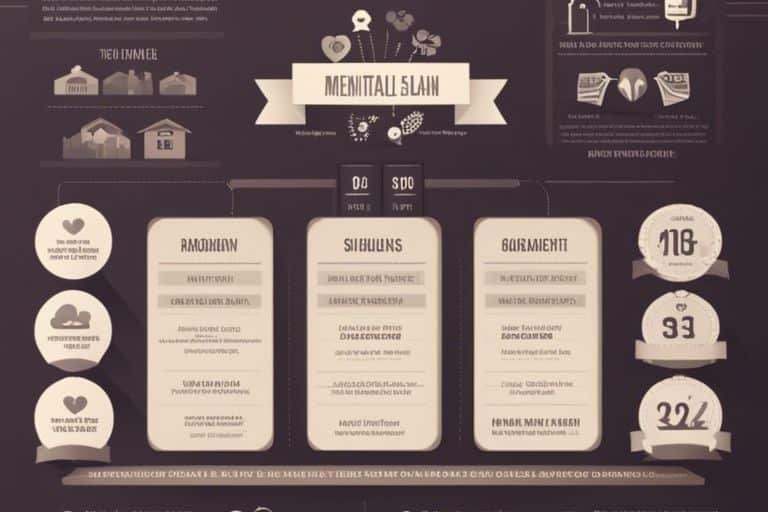Most people are aware of common mental health statistics, but there are some lesser-known facts that shed light on the complexity of this issue. While discussions around mental health have increased in recent years, there are still many obscure statistics that deserve attention. From the correlation between mental health and physical health to the impact of sleep on mental well-being, these lesser-known statistics play a crucial role in understanding the full scope of mental health challenges. In this blog post, we will investigate into some of these lesser-known mental health statistics to provide a more comprehensive understanding of this important topic.
Key Takeaways:
- Mental Health Stigma: Despite progress, there is still a stigma around mental health that prevents many individuals from seeking help.
- Impact on Youth: Approximately 1 in 5 youth experience a severe mental disorder at some point during their life, highlighting the importance of early intervention and support.
- Global Impact: Mental health issues affect people worldwide, with an estimated 450 million individuals currently suffering from such conditions.
Prevalence of Mental Health Disorders
Global Statistics of Mental Health Disorders
It is crucial to understand the prevalence of mental health disorders on a global scale. According to the World Health Organization (WHO), approximately 1 in 4 people worldwide will be affected by a mental health condition at some point in their lives. This statistic highlights the significant impact of mental health disorders on a global level.
Discrepancies in Mental Health Reporting
Mental health reporting can vary greatly between regions and countries, leading to discrepancies in the prevalence of mental health disorders. Cultural differences, stigma surrounding mental health, and inadequate healthcare systems all contribute to underreporting or misrepresentation of mental health statistics. These discrepancies are crucial to address in order to provide accurate data for mental health planning and resource allocation.
Statistics on mental health disorders are often influenced by factors such as access to healthcare, socio-economic status, and cultural beliefs. As a result, it is important to consider these discrepancies when interpreting and comparing mental health statistics from different sources. By acknowledging and addressing these discrepancies, we can better understand the true prevalence of mental health disorders and work towards improving mental health outcomes globally.
Demographic Insights
Mental Health Among Different Age Groups
Health studies have revealed that mental health issues can affect individuals of all ages, but the prevalence and nature of these conditions can vary significantly across different age groups. Younger individuals, especially teenagers and young adults, often struggle with conditions like anxiety and depression due to academic pressure, social media influence, and transitioning into adulthood. On the other hand, older adults may experience mental health challenges such as loneliness, grief, and cognitive decline as they age.
Gender-Specific Mental Health Statistics
Different genders can also experience mental health issues differently. Women tend to be more prone to mood disorders like depression and anxiety, while men may be more susceptible to substance abuse and anger management issues. It is imperative to consider these gender-specific statistics when designing mental health interventions and support systems to cater to the diverse needs of individuals.
Gender-specific mental health statistics highlight the importance of considering the unique challenges that men and women face in terms of mental well-being. Understanding these differences can aid in developing targeted interventions and support services that address the specific concerns of each gender, ultimately promoting better mental health outcomes for all individuals.

Lesser-Known Mental Health Conditions
Overview of Rare Mental Health Disorders
Not all mental health conditions are widely understood or talked about. Some lesser-known disorders exist that may be rare but are no less serious or impactful on individuals who experience them.
Impact and Challenges of Obscure Conditions
To shed light on the impact and challenges faced by individuals with rare mental health disorders, it is crucial to recognize the unique struggles they go through. These conditions often come with limited awareness, leading to inadequate support and treatment options, which can exacerbate the difficulties faced by those affected.
For instance, individuals with Stendhal Syndrome may experience overwhelming anxiety and physical symptoms when exposed to beautiful art or scenery. This rare condition can significantly impact their ability to enjoy cultural experiences and lead to social isolation due to the distress it causes.

Access and Treatment
Availability of Mental Health Resources Worldwide
All too often, individuals around the world encounter barriers when seeking mental health support. According to the World Health Organization (WHO), approximately 75% of people with mental, neurological, and substance use disorders receive no treatment for their conditions. This alarming statistic highlights the urgent need for improved access to mental health resources on a global scale.
Innovations and Improvements in Mental Health Care
Availability of mental health services has seen significant improvements in recent years, with the integration of technology playing a crucial role. Innovations such as teletherapy, mental health apps, and online support groups have made it easier for individuals to access mental health care remotely. These advancements have not only increased accessibility but also helped reduce the stigma associated with seeking help for mental health concerns.
It is imperative for mental health care providers and policymakers to continue investing in technology-driven solutions and implementing policies that ensure equitable access to mental health services for all individuals worldwide. By embracing these innovations, we can work towards a future where mental health support is readily available to anyone in need.
Stigma and Misconceptions
The Effects of Stigma on Mental Health Statistics
Health statistics related to mental illness are often skewed due to the pervasive stigma surrounding mental health. Stigma can lead to underreporting of mental health issues, causing a significant gap in our understanding of the true prevalence of mental illness in society. This lack of accurate data hinders efforts to address and support those in need of mental health services.
Debunking Common Myths About Mental Illness
The misconceptions and myths surrounding mental illness can be damaging and perpetuate stigma. It is crucial to debunk these myths to create a more informed and supportive environment for individuals struggling with mental health conditions. By challenging these misconceptions, we can promote understanding, empathy, and proper mental health education.
Understanding the facts about mental illness is crucial in combating stigma and promoting mental health awareness. Myths such as “mental illness is a sign of weakness” or “people with mental illness are dangerous” are not only false but also harmful. Education and open discussions about mental health are vital in breaking down these misconceptions and creating a more accepting and supportive community for everyone.
Summing up
With these considerations about obscure mental health statistics, it is clear that awareness is crucial in understanding the breadth of mental health challenges individuals face. By shedding light on these lesser-known facts, we can work towards a more informed and supportive society for those dealing with mental health issues. It is imperative to continue researching, discussing, and addressing mental health to ensure that everyone receives the care and support they deserve.
FAQ
Q: What are some lesser-known statistics about mental health?
A: While many people are aware of common mental health statistics, such as depression and anxiety rates, there are also lesser-known statistics worth noting. For example, around 1 in 25 adults in the U.S. experiences a serious mental illness in a given year, which equates to approximately 10 million people. Additionally, suicide is the 10th leading cause of death in the U.S., with rates increasing over the past two decades.
Q: How do mental health statistics vary among different demographics?
A: Mental health statistics can vary significantly among different demographics. For instance, women are more likely than men to experience depression, with the highest rates occurring among those aged 18 to 25. People of color, particularly Black and Hispanic individuals, are less likely to receive mental health treatment compared to white individuals. Furthermore, LGBTQ+ youth are at a higher risk for mental health disorders due to discrimination and stigma.
Q: What impact do mental health statistics have on society?
A: Mental health statistics have a profound impact on society in various ways. They not only shed light on the prevalence of mental health disorders but also highlight disparities in access to care and treatment. By understanding these statistics, policymakers, healthcare professionals, and the general public can work towards improving mental health services, reducing stigma, and ultimately creating a healthier and more supportive environment for those affected by mental illness.








